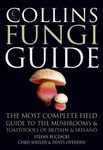About this book
Language: English
According to the micromorphology, eleven new Tremella taxa are proposed, including nine species collected in Taiwan and two in Germany, namely Tremella giraffa C.-J. Chen, T. cerebriformis C.-J. Chen, T. flava C.-J. Chen, T. fuscosuccinea C.-J. Chen, T. griseobrunnea C.-J. Chen, T. neofoliacea C.-J. Chen, T. nivalis C.-J. Chen, T. resupinata C.-J. Chen, T. taiwanensis C.-J. Chen, T. tropica C.-J. Chen, and T. vasifera C.-J. Chen. In addition, fourteen Tremella and one Sirobasidium species are studied morphologically in detail. They are: T. aurantia Schw.: Fr., T. australiensis Lloyd, T. brasiliensis Lloyd, T. samoensis Lloyd, T. encephala Pers.: Bref., T. exigua Desm., T. foliacea Pers.: Fr., T. fuciformis Berk., T. globospora Reid, T. mesenterica Retz.: Fr., T. microspora Lloyd, T. moriformis (Fr.) Smith ex Berk., T. mycophaga Martin, and Sirobasidium magnum Boed.
Morphological and molecular phylogenetic evaluations yielded five groups in the genus Tremella. They are:
1. Aurantia group: basidiocarps heterogeneously mixed with basidiomycetaceous, host hyphae up to the subhymenium, basidia mostly pyriform to capitate, subhymenial structure loose, haustoria abundant; including T. aurantia, T. australiensis, T. encephala, T. microspora, and T. giraffa.
2. Foliacea group: basidiocarps foliose and brown, basidia mostly oval, subhymenium with numerous anastomoses, tenninally swollen cells in the inner parts of basidiocarps, haustoria rare; including T. foliacea sensu lato, T. fuscosuccinea, T. griseobrunnea, T. neofoliacea, T. mycophaga, T. simplex, and T. vasifera.
3. Fuciformis group: basidiocarps heterogeneously associated with Hypoxylon ascocarps, basidia mostly oval, subhymenium with numerous anastomoses, terminally swollen cells in the inner parts of basidiocarps, haustoria rare, haustorial hyphae heavily branched between the interface of parasites and hosts; including T. flava, T. fuciformis, T. resupinata, and T. samoensis.
4. Indecorata group: basidiocarps heterogeneously associated with pyreno-mycetaceous perithecia, basidia mostly pyriform to clavate, subhymenia loose, terminally cells in the inner parts of basidiocarps, haustoria rare, including T. exigua, T. globospora, T. moriformis and T. nivalis.
5. Mesenterica group: basidiocarps gyrose to cerebriform, yellowish, basidia oval, hyphidia existing, subhymenial structure loose, terminal cells in the inner parts of basidiocarps lacking, haustoria abundant but haustorial hyphae heavily branched; including T. brasiliensis, T. cerebriformis, T. coalescens, T. mesenterica, T. taiwanensis, and T. tropica.
Relationships inferred from ribosomal DNA sequences compared with those based on morphological characters provide the information for adequate delimitation of taxa. The utilization of large subunit (LSU) 25 S and internal transcribed spacer (ITS) rDNA sequences are potentially useful in taxonomic, ecological, and evolutionary studies. The results of LSU and ITS phylogenies compared with morphological data for the Tremella grouping strongly suggest that using LSU rDNA sequences are better for interpreting the interspecific evolution. On the other hand, ITS rDNA sequences are adequate for the intraspecies level. Moreover, molecular dendrograms imply that the genus Sirobasidium evolved from Tremella.
Contents
1. Introduction 1
2. Materials and Methods 6
2.1. Morphology 6
2.1.1. List of specimens 6
2.1.2. Light microscopy 6
2.1.3. Transmission electron microscopy 6
2.1.3.1. Chemical preparation 7
2.1.3.2. Material preparation 7
2.2. rDNA sequences 8
2.2.1. Genomic DNA extraction and amplification 8
2.2.1.1. Chelex method 10
2.2.1.1.1. DNA extraction 10
2.2.1.1.2. PCR reaction after Chelex isolation 10
2.2.1.1.3. PCR program after Chelex isolation 10
2.2.1.2. Liquid nitrogen method 11
2.2.1.2.1. DNA extraction 11
2.2.1.2.2. PCR reaction after liquid nitrogen isolation 11
2.2.1.2.3. PCR program after liquid nitrogen isolation 12
2.2.2. Cyclic and fluorescence sequencing 12
2.2.3. Neighbor joining alignment 12
3. Results 13
3.1. Morphology 13
3.1.1. Mesenterica group 13
Tremella brasiliensis (Moller) Lloyd 15
Tremella cerebriformis C.-J. Chen 22
Tremella coalescens Olive 26
Tremella mesenterica Schw.: Fr. 29
Tremella taiwanensis C.-J. Chen 44
Tremella tropica C.-J. Chen 48
Tremella flava C.-J. Chen 57
Tremella fuciformis Berkeley 67
Tremella resupinata C.-J. Chen 77
Tremella samoensis Lloyd 82
3.1.3. Indecorata group 85
Tremella exigua Desm. 88
Tremella globospora Reid 92
Tremella moriformis (Fr.) Smith ex Berk. 97
Tremella nivalis C.-J. Chen 101
Tremella foliacea Pers.: Fr. sensu lato 114
Tremella juscosuccinea C.-J. Chen 124
Tremella griseobrunnea C.-J. Chen 128
Tremella mycophaga Martin 131
Tremella neofoliacea C.-J. Chen 135
Tremella vasifera C.-J. Chen 143
3.1.5. Aurantia group 150
Tremella aurantia Schw.: Fr. 152
Tremella australiensis Lloyd 159
Tremella encephala Pers.: Bref 166
Tremella giraffa C.-J. Chen 173
Tremella microspora Lloyd 179
3.1.6. The genus Sirobasidium 187
Sirobasidium magnum Boed. 189
3.2. Ultrastructure 194
3.2.1. Septal pore ultrastructure 194
3.2.2. Haustoria-host hyphae interaction 194
3.3. Morphological phylogenetic analysis 198
3.3.1. Morphological matrix 198
3.3.2. Morphological phylogeny 198
3.4. Molecular analysis 203
3.4.1. rDNA sequences 203
3.4.2. rDNA phylogenetic analysis 204
3.4.2.1. Phylogeny of the large subunit (LSU) rDNA 204
3.4.2.2. Phylogeny of the internal transcribed spacer (ITS) rDNA 204
4. Discussions 208
4.1. Interaction of haustona-host hyphae 208
4.2. Comparison of morphological and molecular phylogeny 209
4.2.1. Mesenterica group 209
4.2.2. Fuciformis group 209
4.2.3. Indecorata group 210
4.2.4. Foliacea group 211
4.2.5. Aurantia group 211
4.2.6. The genus Sirobasidium 212
5. Summary 213
6. Literature 214
7. Index 223
8. Abbreviation 225
Customer Reviews
















![Die Gattung Hyphodontia John Eriksson [The Genus Hyphodontia John Eriksson]](http://mediacdn.nhbs.com/jackets/jackets_resizer_medium/59/59441.jpg?height=150&width=93)



















![Bibliotheca Diatomologica, Volume 38: Insel der Endemiten: Geobotanisches Phänomen Neukaledonien [Island of Endemics: New Caledonia – A Geobotanical Phenomenon]](http://mediacdn.nhbs.com/jackets/jackets_resizer_medium/94/94205.jpg?height=150&width=96)
![Bibliotheca Diatomologica, Volume 15: Bacillariaceae, Epithemiaceae, Surirellaceae [German]](http://mediacdn.nhbs.com/jackets/jackets_resizer_medium/62/62828.jpg?height=150&width=93)





